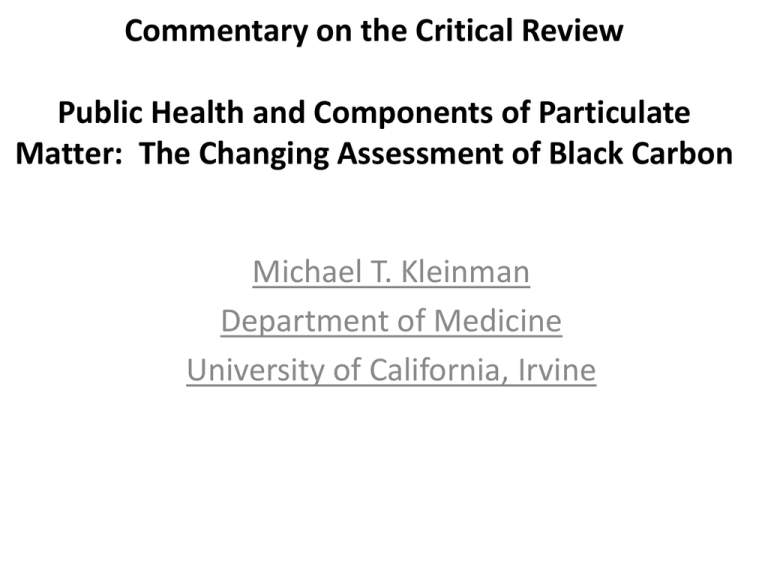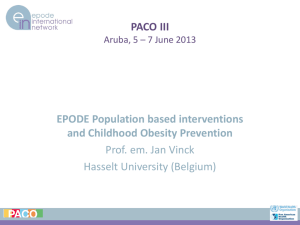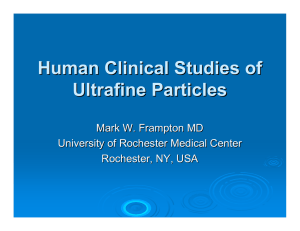Commentary on the Critical Review Public Health and
advertisement

Commentary on the Critical Review Public Health and Components of Particulate Matter: The Changing Assessment of Black Carbon Michael T. Kleinman Department of Medicine University of California, Irvine Recent Findings and Implications of Air QualityRelated Health Research at UC Irvine • Nearly 50% of deaths are associated with heart disease. • Biomarkers of heart disease are associated with organic (OC) and elemental carbon (EC) components of UFP. • EC may be important because large surface area may act as a “carrier” that brings chemicals into areas that they couldn’t ordinarily reach. • EC and BC are possible surrogates for motor vehicle emissions and may also be causally related to CV morbidity and mortality. • Near road exposures promote airway allergies; • PM exposure accelerates atherosclerosis. • PM exposure is associated with inflammation and oxidative stress in the brain. When we studied the effects of ultrafine particles on airway allergies, • The association with allergy biomarkers e.g. IL-5 was: – strongest for elemental carbon (EC) and organic carbon constituents (OC). – not explained by differences in particle number, metals or particle mass concentrations Testing the Roles of Black and Organic Carbon • Human biomarker study (Delfino) indicated importance of UFP organic carbon (OC) constituents related to coronary artery disease. • We had previously shown that UFP accelerates atherosclerosis in mice. • We had also shown that PM is less reactive, in vitro, when we remove the organic constituents from UFP using a denuder (which works analogously to modern diesel afterburner emission controls). • So we tested the hypothesis that removal of the OC from UFP would block the acceleration of atherosclerosis. Ambient Air Electrostatic Classifier 315 lpm Electrostatic Classifier CPC 15 lpm 5 lpm CPC Diffusion Dryer 0.3 lpm Virtual Impactor 10 lpm Condenser 300 lpm Ultrafine Impactor (Dp 50 =180 nm Saturation Tank VACES Pump Adsorption /Cooling 2.5 lpm 4.7 lpm Quartz f ilter 4.7 lpm 5 lpm 2.5 lpm Heater Heater Quartz f ilter Thermodenuder Tef lon f ilter Tef lon f ilter Pump 1. We exposed mice in LA to air, denuded and undenuded PM. 2. We examined serum biomarkers and arteries Black Carbon and Brown Carbon? • Black carbon (BC) is a major component of “soot”, a complex light-absorbing mixture that comprised of a mixture of Elemental Carbon (EC) and Particulate Organic Carbon (OC). • BC is the most strongly light-absorbing component of particulate matter (PM), and is formed by the incomplete combustion of fossil fuels, biofuels, and biomass. • BC is emitted directly into the atmosphere in the form of fine particles (PM2.5) and ultrafine particles (PM0.1). These are also considered nanoparticles. • BC is the most effective form of PM, by mass, at absorbing solar energy: per unit of mass in the atmosphere, BC can absorb a million times more energy than carbon dioxide (CO2). • Organic carbon aerosols are a significant absorber of solar radiation. The absorbing part of organic aerosols is referred to as "brown" carbon (BrC). EC OC + BrC BC http://www.epa.gov/blackcarbon/basic.html Changes in Particle Composition After Thermal Denuding Health-related characteristics of Ultrafine PM -3 dM/dlog10 dva (µg m ) 12 ultrafines less oxygenated (to denuder) quasiultrafines 10 m/z 55 (C4H7 +) 4 2 m/z 44 (CO2+) 0 2 3 4 5 6 7 8 9 100 0.4 1000 m/z 55 (C4H7 When you denude the UFP 3500 Ambient Denuded 2.0 1.5 2 +) dva (nm) 47 % 42 % 66 % 1.0 0.5 Concentraton, pg/m3 DTT activity, nmol/min/m3 2.5 larger particles oxygenated 6 3.5 3.0 Organics Sulfate Ammonium Nitrate 8 5 6 7 8 9 m/z 44 (CO2+) accumulation mode 3000 2500 Ambient HMW PAHs Denuded 14% 2000 53 % 1500 1000 81 % 500 0 0.0 50 C 100 C Temperature 200 C 50 C 100 C Temperature, oC 200 C 4 Removing the Organic Constituents From Ambient UFP Blocks CV Effects Reflections on CR Conclusions • Conclusion: ‘Using the U.S. EPA rubric for judging causality, we conclude that there is a causal relationship between BC/EC for all cause and various CVD mortality and morbidity endpoints.” – The OC may be more associated with disease causality than the EC – If true different mitigation approaches may be necessary to best protect public health. • Conclusion: “…in rapidly developing countries having high levels of air pollution, it is clear that concentrations of BC and PAHs are considerably higher than in the US and Western Europe, and that adverse health outcomes are also highly elevated in these countries. “ – The potential causal role of toxic organic components of combustion emissions suggests that future consideration of more specific metrics of air quality as opposed to “bulk” metrics such as particle mass or particle number may be needed as part of a clean air strategy.




